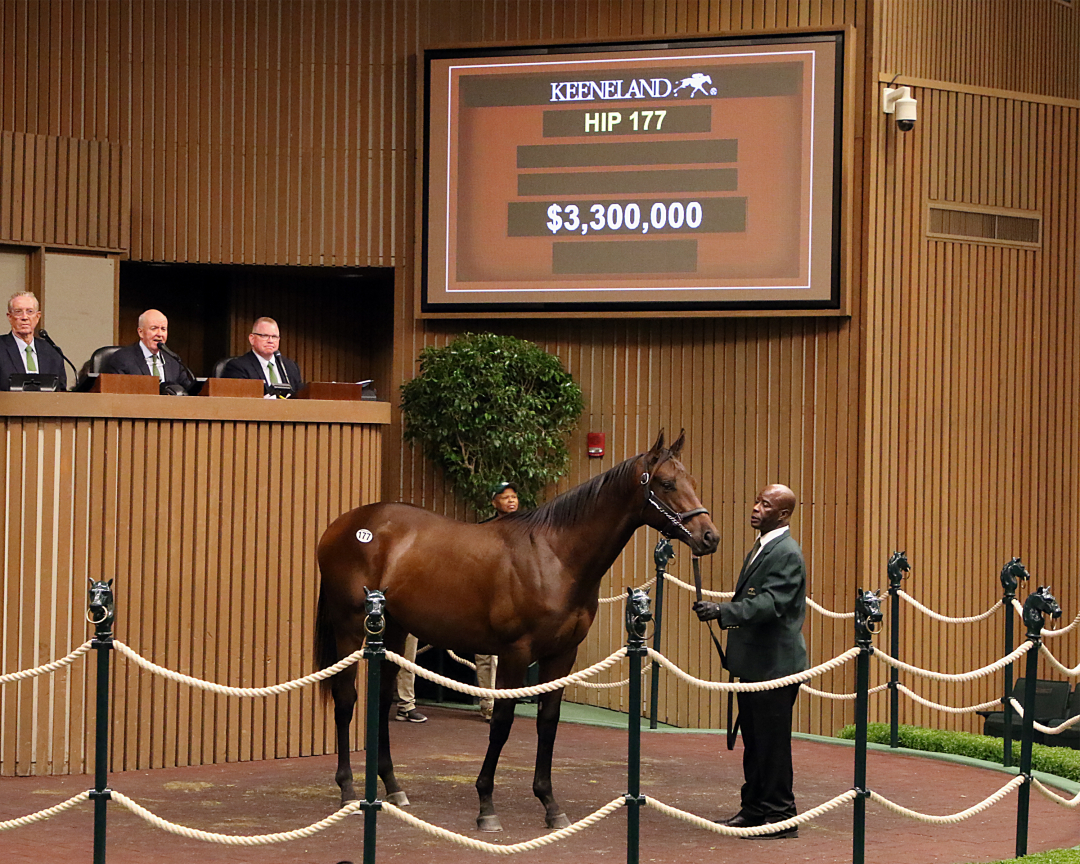LEXINGTON, Ky. – Despite persistent declines in the foal crop and stagnant handle figures for the U.S. racing industry overall, yearling prices at the bellwether Keeneland September sale have soared this year, with all sales figures on track to easily break last year’s records when the 12-day sale concludes Saturday.
Those gaudy figures have been produced just one month after two Fasig-Tipton sales in upstate New York – one for so-called “select” yearlings and the other for New York-bred horses – produced similarly spectacular results, setting records across the board.
To the horse racing fan who is only a casual observer of the bloodstock scene, the rapid escalation in yearling prices seems incongruous with the general state of the racing industry. Sure, average purses are at record highs, with Kentucky making massive gains over the past decade, but those numbers are entirely due to the impact of casino subsidies and a consistent reduction in racing opportunities due to shrinking populations of available horses. Racetracks keep closing, while handle has failed to keep up with inflation for two decades.
While it’s common for sales officials to commend their teams for putting together catalogs of horses particularly attractive to buyers and to heap praise on their consignors for bringing sound and stout horses to the grounds to explain the recent explosion in prices, the answer is actually found in the halls of Washington, D.C., rather than the farms and sales offices in Central Kentucky.
Earlier this year, Congress, in a highly partisan vote, approved a sweeping tax-and-spending bill supported by Republicans and business interests. Contained in the bill, in part due to heavy lobbying by the racing industry’s D.C. representatives, were extremely generous provisions favoring the owners of assets, small businesses, and general partnerships – well-capitalized groups that include the vast majority of horse owners.
Len Green, the co-founder of D. J. Racing Stable and the founder of The Green Group, an accounting firm that has 800 racing clients, said that it was impossible to separate the passage of the bill from the recent run-up in bloodstock prices.
“It is a major, major, major part of what we are seeing right now,” said Green, who attended the first four days of the Keeneland September sale. “It’s probably the reason we are seeing what we are seeing right now.”
Specifically, the bill provided 100 percent “bonus depreciation” to classes of assets including sport or breeding horses, allowing buyers to write off the upfront cost of a horse in its first year. It also contained beneficial language for the definition of the types of horses that are eligible for bonus depreciation – previous language included the term “racehorse,” which in some IRS offices meant a horse that had started in a race. The new language applies to any horse meant for racing, allowing depreciation to kick in once the horse begins training for its racing career.
More generally, the tax bill allows business owners to offset losses from one business to any other business. So, if a horse owner also runs a profitable consulting business, losses from the racing operation can be used to offset the tax bill of the consulting business. In addition, the bill lowered the requirements for owners to qualify for the deductions by redefining how many hours are necessary to treat a “hobby” as a business instead, among other beneficial provisions.
“There’s a lot of hidden gems in there,” Green said.
Horse owners began enjoying 100 percent bonus depreciation in 2017, under a bill passed during the first Trump administration. Under the bill’s terms, however, bonus depreciation began being reduced by 20 percent every year starting in 2023. Prior to the most recent bill passing, the depreciation schedule had been whittled to 40 percent. The new bill made the 100 percent schedule permanent, meaning it will take a separate act of Congress to change it in the future.
The National Thoroughbred Racing Association, which conducts lobbying for the racing industry, threw its entire weight this year behind the effort to re-authorize 100 percent bonus depreciation and other favorable language. That’s not lost on sales officials or consignors, which represent horse sellers at auctions.
“I think you’ve got to give some credit, and a nod, to all of the work that was done in Washington, D.C., and the depreciation,” said Shannon Arvin, chief executive of Keeneland. “That’s helping fuel some of the demand, which is incredible.”
“This 100 percent bonus depreciation is back on, and that’s huge for our game,” said Peter O’Callaghan, owner of Woods Edge Farm, a major consignor.
Still, like the mortgage-interest tax deduction, which most economists believe pushes up house prices and does little to nothing to benefit any home buyers in the long-term other than the rich, the new policies may not seem to benefit horse buyers as much as they might think. Simply put, the policies make it less expensive to own a racehorse. But now buyers are paying an average 20 percent premium to acquire the horses that benefit from those policies.
“This is obviously a great, great time to be selling horses,” Green said. “But if you’re a buyer, you’re having to spend a lot more to get them.”
– additional reporting by Nicole Russo
:: Want to learn more about handicapping and wagering? Check out DRF's Handicapping 101 and Wagering 101 pages.

